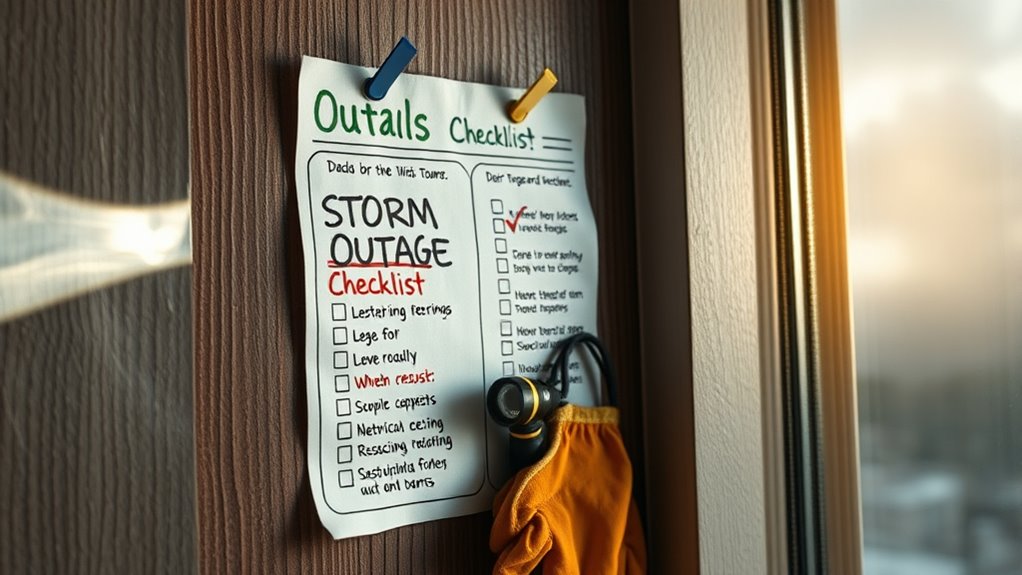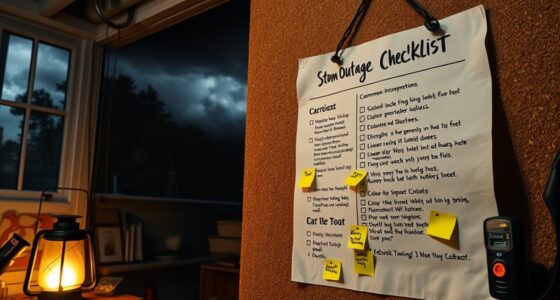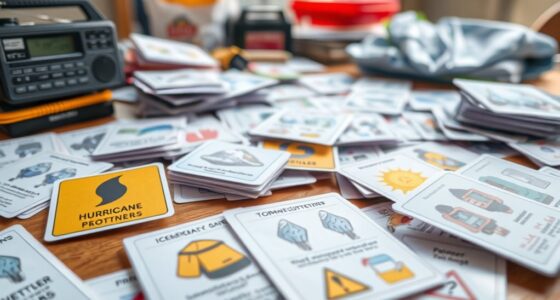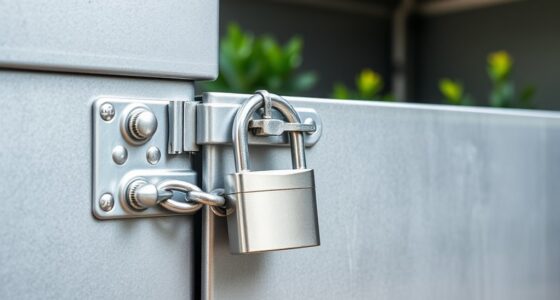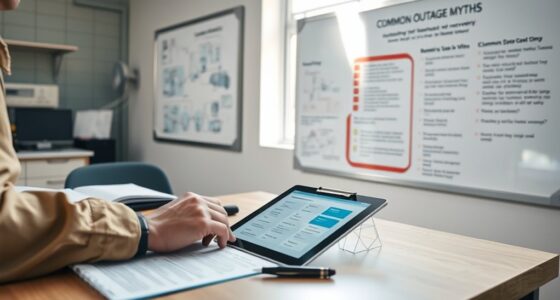During storm season, it’s essential to follow a clear outage checklist to prevent small issues from turning into power failures. Start by verifying your main power switch, then check your circuit breaker panel for trips or overloads. Examine external utility lines for damage and test multiple outlets and devices. Reset equipment properly and keep emergency supplies ready. Knowing when to contact your utility provider can save you time. Follow these steps to stay prepared and learn more about keeping your power on during storms.
Key Takeaways
- Verify external power sources and utility lines before inspecting your home’s electrical system.
- Reset and confirm the main circuit breaker is functioning properly and not tripped.
- Test multiple outlets and devices to identify if the outage is localized or widespread.
- Maintain and regularly test backup power sources and emergency supplies for readiness.
- Contact utility providers promptly to report outages and escalate unresolved issues.
Always Confirm the Main Power Switch Is On
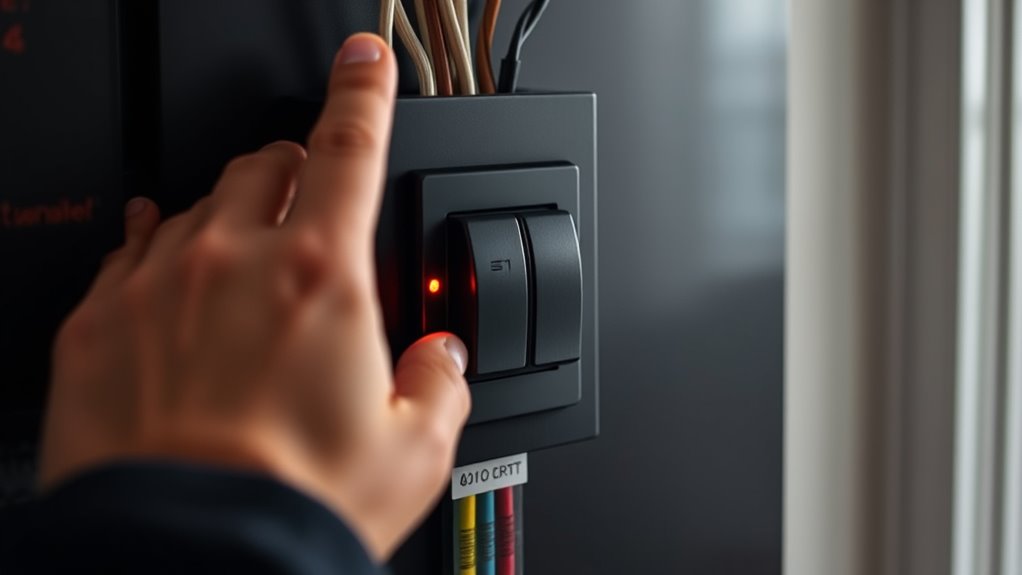
Before troubleshooting any outage, you should always start by confirming that the main power switch is on. The main switch controls the flow of electricity to your home, so ensuring it’s turned on is your first step. Perform a quick power confirmation by locating the main switch, usually found near your electrical panel or outside your home. If the switch is off, simply flip it to the “on” position. Sometimes, the switch may appear on but isn’t fully engaged, so double-check its position. Confirm that the power is flowing by observing any indicator lights or signs of activity. Additionally, understanding the Types of Cookies used on your devices can help troubleshoot connectivity issues related to network settings, which might impact your power management systems. This initial step prevents unnecessary troubleshooting and helps you identify whether the outage originates from your main power source.
Check Your Circuit Breaker Panel First

If your home experiences an outage, start by inspecting your circuit breaker panel. Confirm your circuit safety by turning on the main breaker if it’s off. Look for any breakers that have tripped—these will typically be in the off position or somewhere between on and off. Proper breaker labeling helps you identify which circuit controls which areas of your home, making troubleshooting faster. Reset any tripped breakers by flipping them fully off, then back to on. Avoid forcing breakers if they’re stuck or won’t stay on, as this could indicate a deeper issue. Checking your breaker panel first is a simple, effective step to restore power safely. Always prioritize circuit safety and be cautious when handling electrical panels. Understanding electrical safety ensures you handle outages effectively and securely.
Inspect for Overloaded Circuits or Tripped Breakers

When you’re troubleshooting a power outage, checking for overloaded circuits or tripped breakers is a crucial step. Circuit overloads can cause breakers to trip, cutting power unexpectedly. Look at your breaker panel and identify any switches in the off position or marked as tripped. Resetting these correctly can restore power. Be cautious: if a breaker trips again, it signals a persistent issue needing further investigation. Additionally, understanding family photoshoot fails can help you prepare your space to avoid accidental disruptions during power tests.
Examine External Power Sources and Utility Lines

Since external power sources and utility lines supply the electricity to your home, inspecting these connections is a vital step in troubleshooting outages. First, check if the utility pole or transformer nearby shows signs of damage or downed lines. Look for any fallen utility wires or sparks that could indicate a problem outside your property. Contact your utility company to report outages or ask about ongoing issues affecting your area. Make certain that your external power sources, like generators, are properly connected and functioning if you rely on them. Sometimes, the issue isn’t inside your home but with the utility lines or external power sources. Confirm that utility service is active before investigating further inside your home to avoid unnecessary troubleshooting steps. Additionally, understanding power grid stability can help you better assess the likelihood of widespread outages impacting your area.
Test Other Devices and Outlets to Isolate the Issue
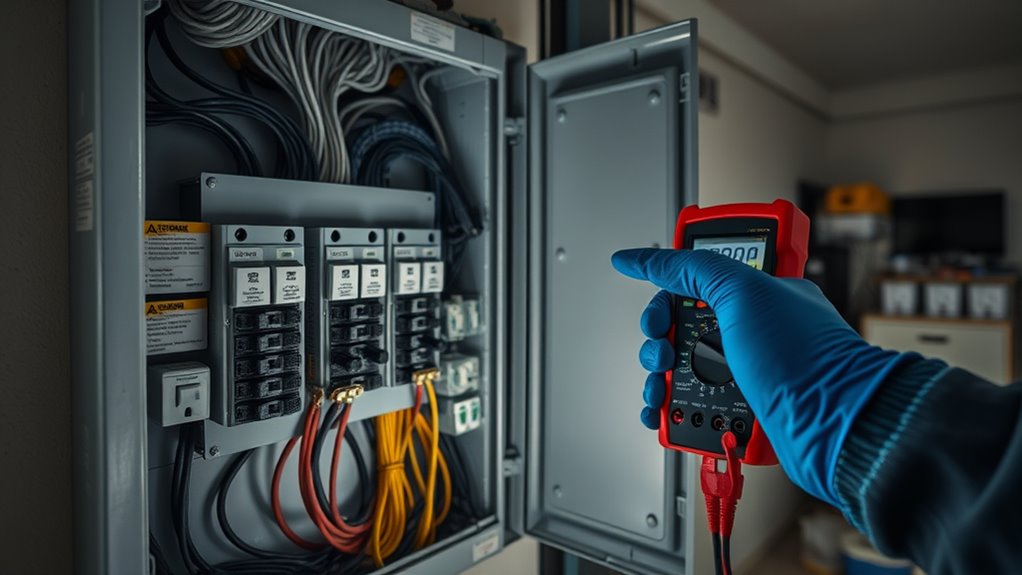
To pinpoint whether the outage is limited to a specific device or affects multiple outlets, start by testing other devices and outlets throughout your home. This is where outlet testing becomes essential. Plug in different appliances or electronics into various outlets to see if they work. If multiple outlets are unresponsive, the problem may be with your home’s wiring or circuit breaker. Check device compatibility to confirm your devices aren’t faulty or incompatible with your electrical system. If certain devices work in some outlets but not others, it indicates a localized issue. This step helps you narrow down whether the problem is isolated or widespread, guiding your next troubleshooting steps. Remember, consistent testing provides a clearer picture of where the outage originates. Additionally, understanding remote work productivity can help you organize and prioritize your troubleshooting process more efficiently.
Reset and Restart Your Electrical Equipment Properly

To reset your equipment safely, start by powering down devices properly to prevent damage. Make sure you follow the correct reset method for each piece of equipment to guarantee it restarts correctly. Once you’ve reset everything, verify that your devices are functioning as they should.
Power Down Safely
Before resetting or restarting your electrical equipment, it’s essential to power down safely to prevent damage or injury. Follow proper grounding procedures to avoid electrical shock and ensure safety. Using power surge protection devices can also safeguard your equipment from voltage spikes during shutdown. Always unplug devices before turning off power to prevent surges that might damage sensitive components. Incorporating smart marketing strategies can help promote your safety protocols and ensure awareness among users.
Use Correct Reset Method
After powering down your equipment safely, it’s important to follow the correct reset procedures to prevent damage and ensure a proper equipment reboot. Start by unplugging devices and waiting a few moments before reconnecting them. When restarting, turn devices on in the right order—usually from the main power source to individual components. Avoid rushing through the reset process or skipping steps, as improper resets can cause malfunctions. If your equipment has a dedicated reset button, use it according to the manufacturer’s instructions. Doing so guarantees a clean reset, clearing any residual issues. Always check your equipment’s manual for specific reset procedures, especially after power outages. Properly resetting your equipment reduces the risk of damage and helps it operate smoothly once power is restored.
Verify Equipment Functionality
Wondering if your equipment is functioning correctly after a storm outage? It’s essential to verify its performance through proper troubleshooting procedures. Start by resetting and restarting your electrical devices carefully, ensuring equipment maintenance is up to date. To help visualize, here’s a quick overview:
| Step | Action | Result |
|---|---|---|
| Power off equipment | Turn off the device completely | Prevents electrical surges |
| Wait 30 seconds | Unplug or switch off power | Clears temporary issues |
| Power on equipment | Turn device back on | Checks functionality |
This process helps identify if your equipment is responsive or needs further troubleshooting. Properly resetting equipment minimizes risks and guarantees suitable performance during storm season. Remember, equipment maintenance is key to avoiding outages and ensuring your devices operate smoothly.
Keep Emergency Supplies and Backup Power Ready
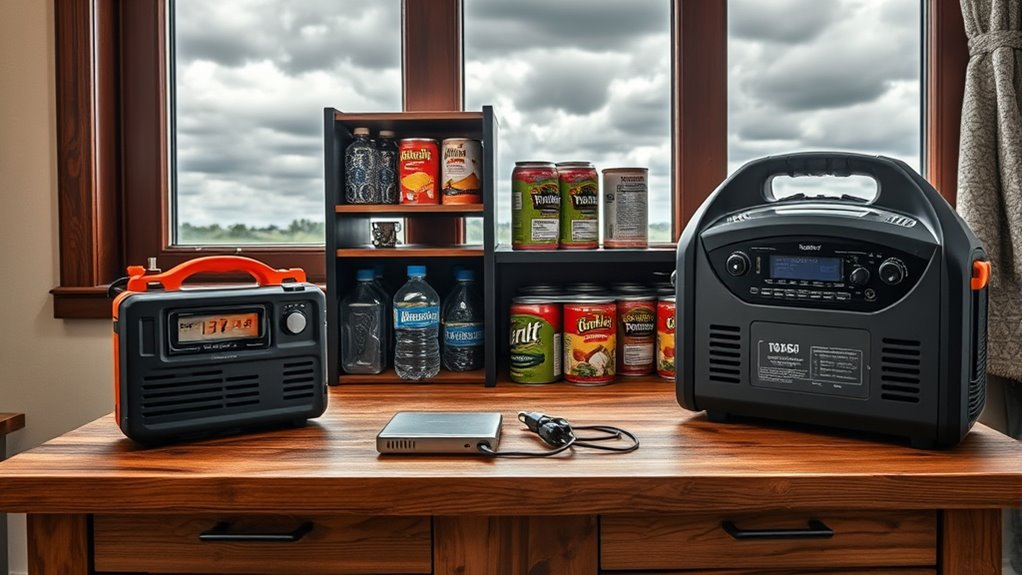
You need to guarantee your emergency supplies and backup power are ready before a storm hits. Stock essential items like water, batteries, and non-perishable food, and regularly test your backup power sources to confirm they work. Keep your emergency kits maintained so you’re prepared to handle outages quickly and effectively. Additionally, understanding your whole-home backup power options can help ensure your system is reliable and safe when you need it most.
Stock Essential Items
Are you prepared to handle a storm-related outage? Stock essential items now to make sure you’re ready when the power goes out. Keep a well-stocked supply of emergency supplies, including non-perishable food, bottled water, batteries, and first aid kits. These stock essentials can sustain you and your family during prolonged outages. Check expiration dates regularly and replenish supplies as needed. Having a designated emergency kit makes it easier to access critical items quickly. Remember, storm season can be unpredictable, so staying proactive in maintaining your supplies minimizes stress and keeps you safe. Being prepared with the right essentials means you won’t have to scramble when the storm hits. Stay organized, stay stocked, and stay safe during storm season. Consider creating a safety checklist to ensure all critical items are accounted for and easily accessible during an outage.
Test Backup Power
Once you’ve stocked up on emergency supplies, it’s important to verify that your backup power sources are ready to go. Start by performing regular generator maintenance, ensuring it operates smoothly when needed. Run the generator under load to check for issues and listen for unusual sounds. Don’t forget to test the batteries—perform battery testing to confirm they hold a charge and are functioning properly. Replace any weak or dead batteries before storm season hits. If you use a portable generator, make sure it’s filled with fresh fuel and stored in a safe, accessible location. Confirm all connections are secure, and familiarize yourself with startup procedures. Regular testing guarantees your backup power will activate instantly, keeping your home powered during outages. Additionally, understanding the importance of proper maintenance can help prevent malfunctions and prolong the lifespan of your backup systems.
Maintain Emergency Kits
Maintaining your emergency kits guarantees you’re prepared for storm outages and can access necessary supplies when needed. Regularly check your kit to guarantee it contains first aid supplies, non-perishable food, water, and batteries. Keep backup power sources, like portable chargers and generators, ready to use. Include communication plans in your kit, such as battery-powered radios and spare cell phone chargers, so you can stay informed and connected. Review and update your supplies seasonally, replacing expired items and adjusting for family needs. Organize everything in a durable, accessible container. By staying proactive, you secure vital resources are on hand during emergencies, reducing stress and improving safety when storms strike. Preparedness starts with a well-maintained emergency kit.
Know When to Contact Your Utility Provider
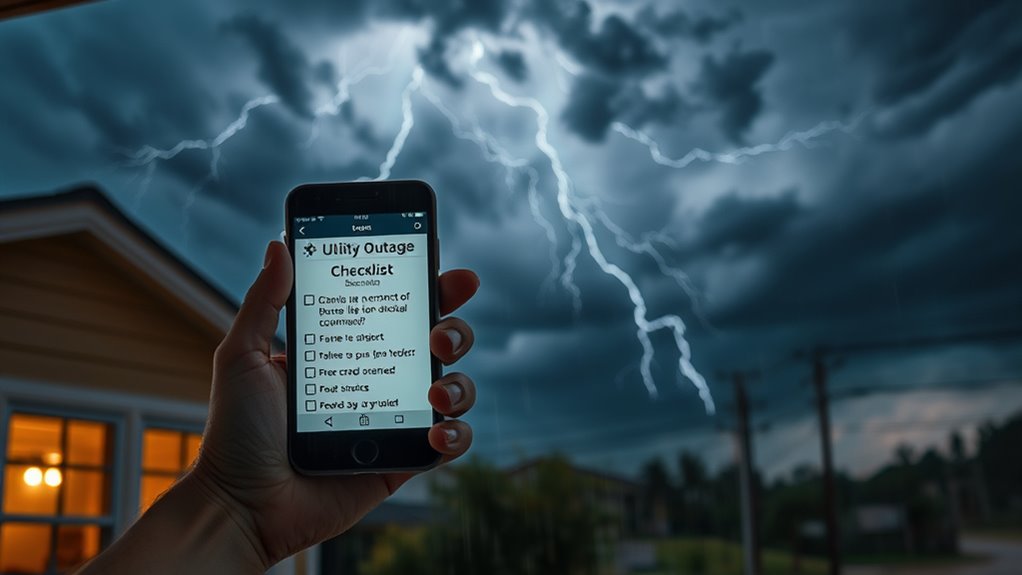
Knowing when to contact your utility provider can save you time and help resolve outages more efficiently. If you notice a prolonged blackout or receive no outage notification from utility communication systems, it’s time to reach out. Contact your provider if your neighbors have power but you don’t, or if your outage persists beyond the expected repair time. Use the utility’s outage reporting channels to ensure your issue is logged and prioritized. Below is a helpful reference:
| Situation | Action |
|---|---|
| No outage notification received | Contact your utility provider |
| Power out but neighbors have power | Report the outage immediately |
| Outage lasts longer than estimated repair time | Call for an update |
| Utility communication shows ongoing repair | Confirm progress with your provider |
| Persistent outage despite updates | Escalate the issue with detailed info |
Timely contact ensures prompt assistance.
Document and Report Persistent Outages or Problems

When you experience a persistent outage, documenting the problem thoroughly helps guarantee it gets the attention it needs. Start by noting the date and time the outage began, and keep a detailed record of any damages or unusual conditions. Take photos if possible, especially if there’s physical damage to your property or utility infrastructure. When reporting outages, provide clear descriptions and mention any specific issues like flickering lights or equipment malfunctions. Accurate documentation makes it easier for utility companies to assess the situation quickly and prioritize repairs. Keep a log of all communications, including dates, times, and names of representatives you speak with. This organized approach ensures your outage gets the proper attention and helps resolve the problem faster.
Frequently Asked Questions
How Can I Prevent Storm-Related Power Outages?
To prevent storm-related power outages, prioritize storm preparedness by trimming trees near power lines and securing outdoor equipment. Install surge protectors and backup power sources like generators to minimize outage impact. Keep an emergency kit ready, and stay informed about weather alerts. Regular maintenance of your electrical system also helps with outage prevention. Being proactive guarantees you’re prepared and can reduce the chances of power disruptions during storms.
What Safety Precautions Should I Take During Outage Troubleshooting?
Imagine a lightning bolt striking right next to you—that’s how dangerous electrical hazards can feel during outage troubleshooting. Always turn off your generator and verify proper grounding before working. Wear insulated gloves and use tools with rubber handles to prevent shocks. Never attempt repairs near downed power lines, and keep a fire extinguisher nearby. Prioritize generator safety and stay alert to avoid accidents that can turn small issues into disasters.
How Do I Choose a Reliable Backup Generator?
To choose a reliable backup generator, you should consider its power capacity to meet your needs and verify it’s well-maintained regularly. Check the manufacturer’s reputation, reviews, and warranty. Proper fuel storage is essential—use sealed containers and keep fuel fresh to prevent issues. Additionally, choose a generator with easy access for maintenance, and consider professional installation to ensure safety and efficiency during outages.
What Signs Indicate My Electrical System Needs Professional Inspection?
You should call a professional if you notice frequent power outages or flickering lights, which can signal electrical system issues. Burning smells, sparks, or exposed wiring are clear signs you need expert help. During storm safety, verify your system is inspected to prevent hazards and speed up power restoration. Addressing these signs promptly keeps your home safe and ensures reliable power during storm season.
How Often Should I Review and Update My Storm Outage Preparedness Plan?
You should review and update your storm outage preparedness plan at least once a year, ideally before storm season begins. During this review, focus on storm safety, outage communication, and ensuring your supplies and contact info are current. Regular updates help you stay prepared, adapt to new risks, and improve your response times. Keep your plan fresh to protect yourself and your loved ones when the next storm hits.
Conclusion
Remember, nearly 80% of outages are fixable with simple troubleshooting steps. By following these rules, you can often resolve issues quickly and stay safe during storm season. Staying prepared not only minimizes downtime but also helps protect your home and loved ones. So, keep this checklist handy, stay vigilant, and don’t hesitate to contact your utility provider if problems persist. Being proactive makes all the difference when storm outages strike.
